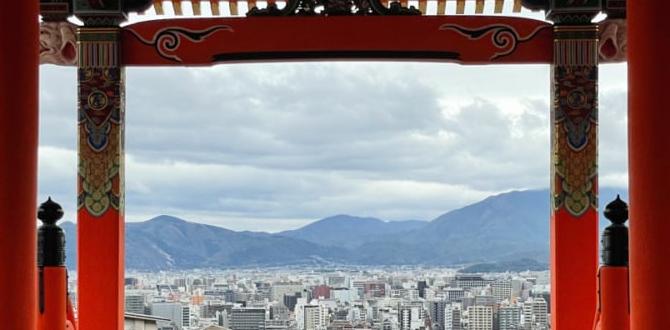Planning a trip to Bali? This guide offers the best advice for smooth travel. Discover essential tips for accommodation, activities, packing, and navigating the island to ensure a stress-free and unforgettable Bali adventure.
Dreaming of Bali? The Island of the Gods beckons with its stunning beaches, lush rice terraces, and vibrant culture. But planning a trip can feel overwhelming. Where do you even begin? Many travelers wonder about the best spots to stay, what to pack, and how to get around without a hitch. Don’t let the details dim your excitement! We’re here to break it all down. Let’s dive into the essential tips to make your Bali journey comfortable and thoroughly enjoyable. Get ready to explore Bali like a pro from the moment you start planning!
Your Ultimate Bali Island Travel Guide: Essential Tips
Bali is a tropical paradise that offers something for every kind of traveler. Whether you’re seeking serene beaches, adventurous treks, spiritual retreats, or a vibrant nightlife, this island has it all. To make sure your trip is as smooth and enjoyable as possible, here are some essential tips to help you navigate your Bali adventure.
1. When to Visit Bali: The Best Time for Your Trip
Bali experiences a tropical climate with two main seasons: dry and wet. Understanding these will help you plan for the best weather and avoid peak crowds if that’s your preference.
- Dry Season (April to September): This is generally considered the best time to visit Bali. You’ll enjoy sunny days, lower humidity, and less rainfall, making it ideal for beach activities, exploring temples, and outdoor adventures. May, June, and September are particularly popular months, offering good weather with slightly fewer crowds than July and August.
- Wet Season (October to March): Expect higher humidity and more frequent rain showers, which can sometimes be heavy but often brief. Despite the rain, Bali is still beautiful during this time. Prices for accommodation and flights might be lower, and there are fewer tourists. You can still enjoy many activities, especially in the mornings, and the lush greenery is particularly vibrant. Be prepared for occasional disruptions to outdoor plans.
Shoulder Seasons: Consider traveling during the shoulder months of April/May or September/October. You can often catch good weather while avoiding the peak season crowds and prices.
2. Getting to Bali: Flights and Arrival
Ngurah Rai International Airport (DPS), also known as Denpasar Airport, is Bali’s main gateway. Numerous airlines offer direct or connecting flights from major cities around the world.
- Booking Flights: Book your flights in advance, especially if you are traveling during the peak dry season (June-August) or during holidays. Use flight comparison websites to find the best deals.
- Visa Requirements: Many nationalities can enter Bali visa-free for short stays or obtain a visa on arrival. It’s crucial to check the latest Immigration regulations for your specific country before you travel. Ensure your passport is valid for at least six months beyond your intended stay.
- Airport Transfer: Upon arrival, you have several options to get to your accommodation:
- Official Airport Taxis: Available outside the arrivals hall. They operate on a fixed-price system to popular destinations.
- Ride-Sharing Apps: Apps like Grab are popular and generally more affordable than taxis, though sometimes there can be designated pick-up zones.
- Pre-booked Private Drivers: Many hotels and tour operators offer airport pick-up services. This is a convenient option, especially if you’re tired after a long flight.
3. Where to Stay in Bali: Choosing Your Base
Bali offers diverse areas, each with its unique charm. Choosing the right area depends on your travel style and what you want to experience.
Popular Areas in Bali: A Quick Overview
Here’s a look at some of the most sought-after regions and what they offer:
| Area | Vibe & Best For | Key Attractions |
|---|---|---|
| Seminyak | Trendy, upscale, beach clubs, shopping, dining. Best for couples, groups, and those seeking a lively atmosphere. | Ku De Ta, Potato Head Beach Club, Seminyak Beach, boutiques, world-class restaurants. |
| Canggu | Bohemian, surfer-friendly, hipster cafes, yoga studios, rice paddies. Best for surfers, digital nomads, and those looking for a relaxed yet trendy scene. | Echo Beach, Batu Bolong Beach, La Brisa, Finns Beach Club, vibrant street art. |
| Ubud | Spiritual heart, cultural hub, lush rainforests, yoga and wellness retreats. Best for culture seekers, yoga enthusiasts, and those wanting tranquility. | Monkey Forest, Tegalalang Rice Terraces, Campuhan Ridge Walk, Ubud Palace, numerous temples. |
| Kuta | Bustling, budget-friendly, lively nightlife, surfing lessons for beginners. Best for backpackers and young travelers on a budget. | Kuta Beach, Discovery Shopping Mall, Hard Rock Cafe, lively bars. |
| Nusa Dua | Luxury resorts, pristine beaches, family-friendly, water sports. Best for families and travelers seeking a pampered resort experience. | Geger Beach, Waterblow, Bali Collection shopping complex, water sports centers. |
| Sanur | Relaxed, laid-back, calm beaches, family-friendly, heritage charm. Best for families, older travelers, and those seeking a quieter beach escape. | Sanur Beach, Turtle Conservation and Education Centre (TCEC), many beachfront restaurants. |
Consider your priorities: Do you want to be close to the surf, immerse yourself in nature and culture, or enjoy luxury resorts? This will guide your choice.
4. Getting Around Bali: Transportation Options
Navigating Bali is part of the adventure! Thankfully, there are many ways to get around, catering to different budgets and comfort levels.
- Scooter Rental: The most popular way for many to explore. It offers flexibility and is relatively inexpensive.
- Pros: Freedom to go anywhere, anytime; great for short distances and exploring small villages.
- Cons: Requires an international driving permit; traffic can be chaotic; risks involved if not an experienced rider. Always wear a helmet!
- Ride-Sharing Apps (Grab/Gojek): These apps are readily available in tourist areas and offer both car and motorbike taxi services. They are generally affordable and convenient.
- Taxis: Metered taxis (like Blue Bird) are a reliable option for getting around towns. Always ensure the meter is used.
- Private Drivers: Hiring a private driver for a day is an excellent way to explore multiple attractions, especially if you’re traveling with family or a group, or want to go further afield. They typically cost around IDR 600,000 – 900,000 (approx. $40-$60 USD) for 8-10 hours.
- Shuttles: Many hotels offer shuttle services, and public shuttle buses (like Perama Tour) connect major tourist hubs, though their routes and schedules can be limited.
Important Note: World Health Organization (WHO) reports that road traffic injuries are a significant global health concern. In Bali, traffic can be unpredictable. If you choose to rent a scooter, ensure you have the correct license and insurance, and always prioritize safety. For those who may have incontinence needs during travel, consider discreet and comfortable adult diapers or pull-ups. These can significantly enhance comfort on long drives or during active exploration, providing peace of mind and freedom to enjoy your journey without worry.
5. What to Pack for Bali: Essentials for Comfort and Convenience
Packing smart for Bali means balancing comfort with practicality. Here’s a checklist to get you started:
Clothing Essentials:
- Lightweight, breathable clothing (cotton, linen).
- T-shirts, tank tops, lightweight shirts.
- Shorts, skirts, comfortable trousers.
- Swimwear.
- A light jacket or sweater for cooler evenings or air-conditioned places.
- A sarong – incredibly versatile for beach cover-ups, temple visits, or as a makeshift towel.
- Modest clothing for temple visits (shoulders and knees covered). Some temples provide sarongs for rent.
Footwear:
- Comfortable walking sandals or flip-flops.
- Water shoes for rocky beaches or water sports.
- Comfortable closed-toe shoes if you plan on trekking or extensive walking.
Health and Personal Care:
- Sunscreen (high SPF), after-sun lotion.
- Insect repellent (especially for evenings).
- Basic first-aid kit (band-aids, antiseptic wipes, pain relievers).
- Hand sanitizer.
- Any personal medications. For those managing incontinence, research travel-friendly Depend products or similar discreet options before your trip.
- Travel-sized toiletries.
Documents and Money:
- Passport (with at least 6 months validity).
- Visa/entry documents (if required).
- Flight and hotel bookings (digital copies are fine).
- Travel insurance details.
- Credit/debit cards and some Indonesian Rupiah (IDR) cash.
Electronics:
- Universal travel adapter.
- Portable power bank.
- Camera and accessories.
- Phone and charger.
Miscellaneous:
- Reusable water bottle.
- Small backpack or daypack.
- Hat or cap for sun protection.
- Sunglasses.
Remember to pack light! You can buy many essentials in Bali if you forget something.
6. Money Matters: Currency, Budgeting, and Payments
Understanding Bali’s currency and common payment methods will make your transactions smooth.
- Currency: The local currency is the Indonesian Rupiah (IDR). Exchange rates fluctuate, but generally, $1 USD is around 15,000-16,000 IDR (check current rates).
- Cash vs. Card: While credit cards are accepted in larger hotels, restaurants, and many shops, cash is king in smaller warungs (local eateries), markets, and for local transport. It’s wise to carry a reasonable amount of cash.
- ATMs: ATMs are widely available in tourist areas. Always use ATMs attached to banks or inside reputable establishments for safety. Inform your bank about your travel dates to avoid card blocking.
- Money Changers: Use authorized money changers with clear signs and official licenses (“Money Changer”). Avoid street money changers offering unrealistic rates, as they can be fraudulent.
- Budgeting: Bali can cater to all budgets.
- Budget Travelers: Can get by on $30-$50 USD per day per person (hostels, local food, scooter).
- Mid-Range Travelers: $50-$100 USD per day (boutique hotels, mix of local and Western food, private drivers occasionally).
- Luxury Travelers: $100+ USD per day (resorts, fine dining, private tours, spa treatments).
7. Food and Drink: Must-Try Balinese Cuisine
Balinese food is a delicious adventure! Don’t leave without trying some local specialties.
- Nasi Goreng: Indonesian fried rice, a staple and often a favorite for many.
- Mie Goreng: Indonesian fried noodles, similar to Nasi Goreng but with noodles.
- Satay: Skewered, grilled meat (chicken, beef, or lamb) served with a flavorful peanut sauce.
- Babi Guling: Roast suckling pig, a ceremonial dish often found in specialized warungs.
- Lawar: A traditional mix of chopped meat, vegetables, and spices.
- Gado-Gado: A salad of blanched vegetables, hard-boiled eggs, tofu, and tempeh, often served with a peanut dressing.
Staying Hydrated: Drink plenty of bottled water. Tap water is not safe to drink. Coconut water is also a refreshing and safe option readily available everywhere.
8. Cultural Etiquette: Respecting Local Customs
Bali is a predominantly Hindu island with unique customs and traditions. Showing respect will enhance your experience and is greatly appreciated by locals.
- Dress Modestly: When visiting temples or rural villages, cover your shoulders and knees. A sarong is ideal for this.
- Temple Etiquette: Always use the provided sashes and sarongs. Never point your feet towards a sacred object or person. Avoid walking in front of people during prayer.
- Respect Sacred Sites: Do not touch offerings (canang sari) left on the ground.
- Greetings: A gentle smile and a nod are usually sufficient. The traditional greeting is “Om Swastiastu” (May peace be with you).
- Left Hand: The left hand is traditionally considered unclean; use your right hand for giving or receiving things, or for eating.
- Public Displays of Affection: While being relaxed, excessive public displays of affection can be seen as disrespectful.
For more in-depth cultural insights, resources like the official Indonesian tourism website of Ministry of Tourism and Creative Economy can be very helpful.
9. Staying Connected: SIM Cards and Wi-Fi
Keeping in touch is easy and affordable in Bali.
- SIM Cards: Purchase a local SIM card at the airport or in town. Providers like Telkomsel offer affordable data packages that are excellent value for navigating, staying in touch, and social media.
- Wi-Fi: Wi-Fi is available in most hotels, cafes, and restaurants. Speeds can vary, so don’t expect blazing-fast internet everywhere, especially in more remote areas.
10. Health and Safety in Bali: Staying Well
Your well-being is paramount. Here are a few key points:
- Sun Protection: The sun in Bali is intense. Always wear sunscreen, a hat, and sunglasses, and stay hydrated.
- Mosquitoes: Use insect repellent, especially at dawn and dusk, to protect against mosquito-borne illnesses like Dengue fever.
- Food and Water: Stick to bottled water and be cautious with street food if you have a sensitive stomach. Look for busy food stalls; high turnover usually means fresher ingredients.
- Medical Facilities: Major tourist areas have reputable clinics and hospitals. Travel insurance is highly recommended.
- Scams: Be aware of common tourist scams (e.g., money changing, taxi overcharging, fake gem souvenirs). If a deal sounds too good to be true, it probably is.
- Incontinence Management While Traveling: For travelers who manage incontinence, proactive planning is key for a comfortable trip. Along with your usual supplies, consider packing extra or purchasing discreet incontinence products locally if possible. Carrying a small, waterproof bag for used products can be very convenient when on the go.
Frequently Asked Questions about Bali Travel
Q1: Is Bali safe for solo female travelers?
Yes, Bali is generally very safe for solo female travelers. Millions of women visit each year without issue. However, like anywhere, it’s wise to be aware of your surroundings, avoid walking alone in poorly lit areas at night, and dress respectfully, especially outside of tourist hotspots.
Q2: How much money should I bring for a week in Bali?
This depends heavily on your travel style. A budget traveler might spend $200-$350 USD for a week, a mid-range traveler $500-$700 USD, and a luxury traveler $700+ USD. It’s always best to have a bit extra for unforeseen expenses.
Q3: Do I need to tip in Bali?
Tipping is not mandatory in Bali, but it is appreciated for good service. In restaurants, a small tip of 5-






